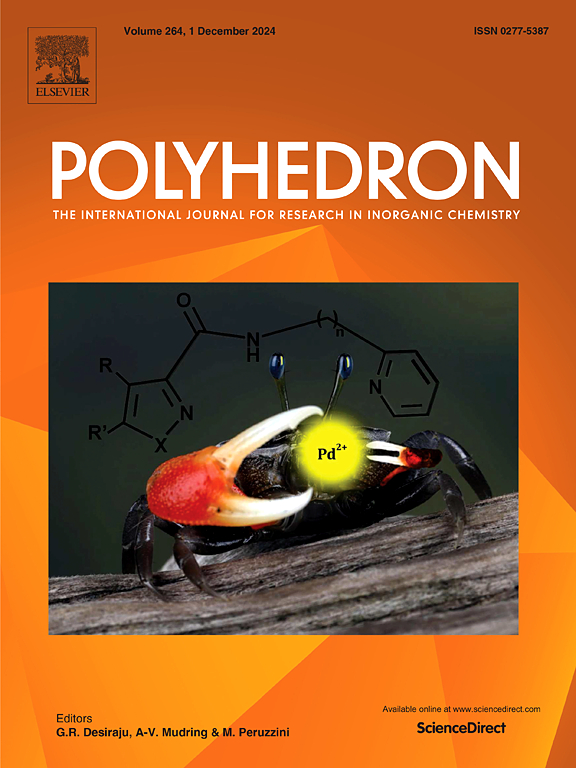含有百里香酚和香芹酚的新型氮扎酚菁:荧光性质的研究
IF 2.6
3区 化学
Q2 CHEMISTRY, INORGANIC & NUCLEAR
引用次数: 0
摘要
具有不同酚衍生物的芳基氮酞菁(AzaPcs)由于其光物理性质在文献中得到了广泛的研究。然而,将百里香酚和香芹酚等天然大体积酚掺入AzaPcs仍未得到充分探索。本研究采用无溶剂法合成了新型百里香酚和香芹酚取代的AzaPcs,并对其结构和荧光性质进行了系统的研究。采用傅里叶变换红外(FT-IR)光谱、紫外-可见(UV-Vis)光谱、质子和碳核磁共振(1H和13C NMR)光谱对合成化合物的分子结构进行了表征。在二甲亚砜(DMSO)中的荧光发射研究表明,所有合成的Zn-azaPcs都表现出红色荧光。进一步分析了Stokes位移、荧光量子产率(Φf)和聚集倾向的荧光行为。值得注意的是,与四元取代的Zn-azaPcs相比,八元取代的Zn-azaPcs的荧光量子产率更高,3a和4a的Φf值分别达到0.22和0.19。发现Zn2+在大环核中的存在通过稳定电子结构和减少非辐射衰变途径来提高荧光效率。聚集研究表明,四取代Zn-azaPcs (1a和2a)表现出更高的聚集倾向,紫外可见光谱中q波段变宽,Stokes位移增加。相比之下,八元取代衍生物(3a和4a)由于巨大的百里酚和香芹酚基团的空间位阻而表现出较低的聚集倾向,这限制了π-π堆积相互作用。这种聚集的减少有助于提高荧光效率和减少斯托克斯位移。这些发现为AzaPcs的结构-性质关系提供了见解,并提出了它们在光电子学和生物成像方面的潜在应用,特别是在关注聚集诱导的荧光猝灭的环境中。本文章由计算机程序翻译,如有差异,请以英文原文为准。

Novel azaphalocyanines containing thymol and carvacrol: Investigation of fluorescence properties
Aryloxyazaphthalocyanines (AzaPcs) with different phenol derivatives have been extensively studied in the literature due to their photophysical properties. However, incorporating natural bulky phenols such as Thymol and Carvacrol into AzaPcs remains underexplored. In this study, novel Thymol- and Carvacrol-substituted AzaPcs were synthesized via a solvent-free method, and their structural and fluorescence properties were systematically investigated. The molecular structures of the synthesized compounds were characterized using Fourier-transform infrared (FT-IR) spectroscopy, ultraviolet-visible (UV–Vis) spectroscopy, proton and carbon nuclear magnetic resonance (1H and 13C NMR) spectroscopy. Fluorescence emission studies in dimethyl sulfoxide (DMSO) revealed that all synthesized Zn-azaPcs exhibited red fluorescence. The fluorescence behavior was further analyzed regarding Stokes shifts, fluorescence quantum yields (Φf), and aggregation tendencies. Notably, octa-substituted Zn-azaPcs exhibited superior fluorescence quantum yields compared to their tetra-substituted counterparts, with Φf values reaching 0.22 for 3a and 0.19 for 4a. The presence of Zn2+ in the macrocyclic core was found to enhance fluorescence efficiency by stabilizing the electronic structure and minimizing non-radiative decay pathways. Aggregation studies revealed that tetra-substituted Zn-azaPcs (1a and 2a) exhibited a higher tendency to aggregate, as indicated by broadened Q-bands in UV–Vis spectra and increased Stokes shifts. In contrast, octa-substituted derivatives (3a and 4a) demonstrated lower aggregation tendencies due to steric hindrance from bulky Thymol and Carvacrol groups, which limited π-π stacking interactions. This reduction in aggregation contributed to higher fluorescence efficiencies and reduced Stokes shifts. These findings provide insights into the structure-property relationships of AzaPcs and suggest their potential applications in optoelectronics and bioimaging, particularly in environments where aggregation-induced fluorescence quenching is a concern.
求助全文
通过发布文献求助,成功后即可免费获取论文全文。
去求助
来源期刊

Polyhedron
化学-晶体学
CiteScore
4.90
自引率
7.70%
发文量
515
审稿时长
2 months
期刊介绍:
Polyhedron publishes original, fundamental, experimental and theoretical work of the highest quality in all the major areas of inorganic chemistry. This includes synthetic chemistry, coordination chemistry, organometallic chemistry, bioinorganic chemistry, and solid-state and materials chemistry.
Papers should be significant pieces of work, and all new compounds must be appropriately characterized. The inclusion of single-crystal X-ray structural data is strongly encouraged, but papers reporting only the X-ray structure determination of a single compound will usually not be considered. Papers on solid-state or materials chemistry will be expected to have a significant molecular chemistry component (such as the synthesis and characterization of the molecular precursors and/or a systematic study of the use of different precursors or reaction conditions) or demonstrate a cutting-edge application (for example inorganic materials for energy applications). Papers dealing only with stability constants are not considered.
 求助内容:
求助内容: 应助结果提醒方式:
应助结果提醒方式:


